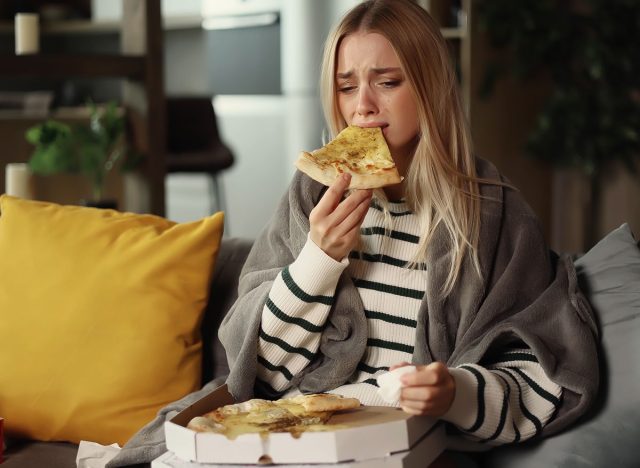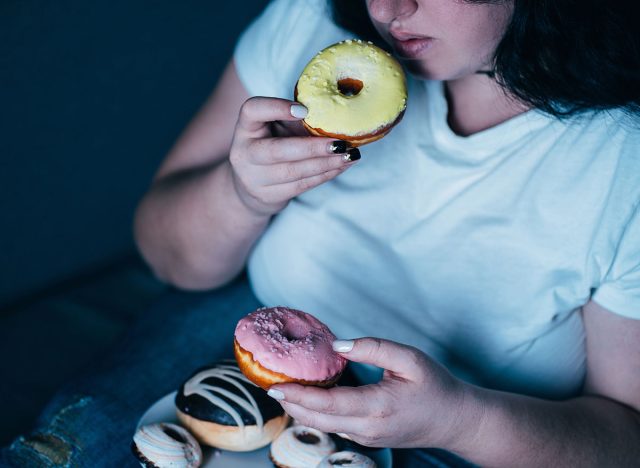I'm a Psychologist and These 6 Tricks Will Finally Stop Your Emotional Eating

Have you ever found yourself reaching for cookies after a stressful meeting or craving ice cream during a tough day? As a psychologist, systemic-relational psychotherapist, and dance movement therapist specializing in emotional regulation, I've seen firsthand how emotions drive our eating patterns. I want to share evidence-based strategies that can help you take control of emotional eating and achieve lasting and sustainable weight loss success. These techniques have helped me and my clients develop healthier relationships with food and their bodies.
Understanding Emotional Eating

Emotional eating behavior is a tendency to overeat in response to negative emotions. It may bring relief in the short term, but this habit can become a long-term problem, leading to a yo-yo effect, body image issues, and weight gain.
The problem often lies not in the negative emotions themselves but in the lack of effective strategies to regulate these feelings. Many clients initially notice changes in their weight or eating patterns but feel stuck when trying to uncover and address the underlying causes.
What is Helpful Emotional Regulation?

A growing body of evidence shows that identifying, describing, and regulating emotions play an important role in eating disorders. Emotional regulation generally refers to an individual's ability to manage and respond to their feelings in ways that do not lead to impulsive or destructive behaviors. It involves recognizing and understanding one's emotional states and finding constructive ways to process these feelings instead of turning to food for comfort.
It's easy to say, but discovering emotional regulation is a journey through your own internal world, and each person will need to find their own pace and commit to the process. First, we need to observe the strategies currently in use, then experiment with new ones to address old challenges with new tools. I recommend not comparing yourself to others during this process.
Unhelpful vs. Helpful Strategies for Managing Emotions

Strong emotions can be uncomfortable, leading some people to cope with unhealthy behaviors like acting impulsively or losing control. While suppressing or avoiding feelings might provide brief relief, these strategies often backfire – creating more stress and making emotions even harder to manage. This cycle frequently leads to emotional eating. You may be suppressing your emotions if you:
- "Control your emotions by not expressing them."
- "Keep your emotions to yourself."
The Power of Reappraisal

Reappraisal is a powerful strategy because it helps manage emotions before they become overwhelming. By changing how we think about situations early on, we can better control our emotional responses and eating habits. Research shows that people who practice reappraisal tend to eat less than those who simply suppress their feelings. You may already be using reappraisal if you:
- When faced with a stressful situation, make yourself think about it in a way that helps you stay calm.
- When you want to feel less negative emotion (such as sadness or anger), you change what you are thinking about.
Here are some positive coping strategies to help you better understand and manage your emotions, reducing emotional eating:
1. Change the Narrative of What's Happening

Negative emotions often make us focus on the worst aspects of a situation. To shift this, try a cooling strategy by changing the way you think about the emotional experience. For example, instead of thinking, "I feel sad because the relationship ended," try reframing it as, "I'm grateful for the good moments I had, even though the relationship didn't last." This shift in perspective can help reduce emotional intensity and prevent turning to food for comfort.
2. Practice Mindfulness

Mindfulness helps you confront impulses and fears, giving you more control over your reactions. It also creates space for observing body position, processes, and sensations, which correspond with better emotional regulation. Start by pausing for three seconds and, instead of ignoring your feelings of stress by eating, acknowledge the emotion and think, "This is temporary. I can handle it without food." Support from guided meditation or apps like Headspace can be beneficial.
3. Stay Curious

Track when you tend to eat emotionally. Are there patterns? Identifying them can help you prepare for the next time. Notice where your thoughts go when you feel down, how your body feels, and any specific moments when you increase your food intake. Recognize when you are stressed and when you are relaxed. It may sound dull, but this self-awareness often serves as the first step toward addressing deeper, underlying issues. The more we understand about our patterns, the easier it becomes to break them and develop healthier habits.
4. Build Tolerance for Emotions

Set a 'worry window' for 10 minutes a day to sit with any uncomfortable emotions without judgment. Instead of ignoring your feelings of stress by eating, acknowledge the emotion and think, "This is temporary. I can handle it without food."
5. Use Self-Compassion

Being indulgent with yourself may bring positive changes in everyday life. Replace negative self-talk with positive affirmations. Each day, say something kind to yourself in the mirror, such as, "Every part of me deserves love and protection."
From my work with clients, I've seen how small acts of kindness can transform the therapeutic process. When self-hatred is gradually replaced with kindness, it often becomes a source of strength in dark times. One client shared how this simple daily practice helped them feel more connected to themselves and built a sense of hope when they needed it most.
6. Engage in Conscious Movement

Conscious movement, such as yoga, stretching, or mindful walking, helps calm the mind and release tension by connecting you to your body, providing a positive, stress-relieving alternative to emotional eating. For instance, one of my clients found yoga to be a transformative tool in their recovery from an eating disorder. After years of feeling disconnected from their body, they shared how the practice of mindful movement allowed them to approach their physical self with compassion and awareness for the first time.
Taking the First Step

Start with just one of these strategies today and notice how even small shifts can make a big difference. Small steps every day will get you much further than trying to run a marathon in one day. If you feel overwhelmed or find it difficult to make these changes on your own, remember that mental health professionals are ready to help. Finding the right therapist may take time, so don't be discouraged if the first attempt isn't the right fit. Keep looking and stay open. And if you enjoyed this article, take advantage of these 15 Quick Ways to Lose Body Fat Percentage in a Week.




